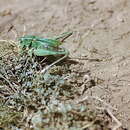Biology
provided by Arkive
The elusive adults are mainly active during the day, males sing only in hot, sunny and still conditions. The species is omnivorous, eating a range of herbs and insects, including even adult grasshoppers. Eggs are laid singly in the ground from early August, hatching two or more years later during May. Six or seven nymphal stages are passed before the adult stage is reached in July. Adults rarely survive later than September.
Conservation
provided by Arkive
The UK Biodiversity Action Plan (BAP) for the wart-biter cricket outlines the long-term aim of restoring the species to former sites and securing its future with 10 self-sustaining populations by 2010. The wart-biter cricket was one of the first species to be targeted by English Nature's Species Recovery Programme. Research into the habitat needs and ecology of the wart-biter cricket began in 1987, and the species has been bred in captivity at London Zoo; some of this stock has been successfully reintroduced into suitably restored habitat at former wart-biter sites. Research has thrown light on the habitat needs of this species, this has allowed appropriate habitat management techniques to be devised and encouraged at all occupied and proposed future sites. Further reintroductions are currently being planned.
Description
provided by Arkive
The wart-biter cricket is a large, dark green bush-cricket, often with dark brown blotches on the pronotum and wings. A keel is present on the pronotum of both sexes and the wings are a little longer than the body. The female ovipositor is long and slightly upcurved. The English name of this species refers to the old Swedish practice of allowing the cricket to bite warts from the skin. The scientific name verrucivorus derives from the Latin, 'verruca' meaning 'wart' and 'vorous' 'to devour'. The distinctive song is only heard in hot sunny weather and consists of a series of rapidly repeated clicks in short bursts, which may last for several minutes.
Habitat
provided by Arkive
The wart-biter typically inhabits sunny, well-sheltered calcareous grassland, however, one British population is known from rough heathland adjacent to improved grassland. The species requires a mosaic of bare ground and short turf for egg-laying and early nymphal stages, and taller tussocks of vegetation for the larger nymphs and adult stages.
Range
provided by Arkive
This species occurs throughout Europe (except the extreme south) and in temperate Asia. In Great Britain it is extremely localised and restricted to southern England where just five populations are now known, one of these, in Kent, has resulted from a reintroduction. Natural populations only occur in East Sussex, Dorset and Wiltshire.
Status
provided by Arkive
Listed as Vulnerable in Great Britain, and protected under Schedule 5 of the Wildlife and Countryside Act 1981.
Threats
provided by Arkive
Threats to this species include unsuitable management of grasslands through reduced grazing leading to scrub invasion, or excessive grazing resulting in a loss of vegetation structure. At some sites with low population densities, predation by birds may be an important factor. In 1999 an illegal concert at a National Nature Reserve (NNR) in East Sussex resulted in the trampling of young wart-biter crickets.

